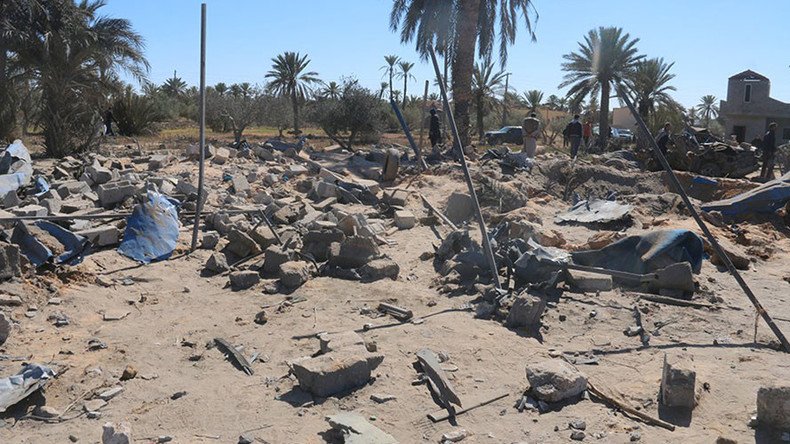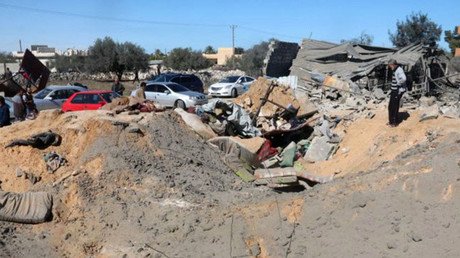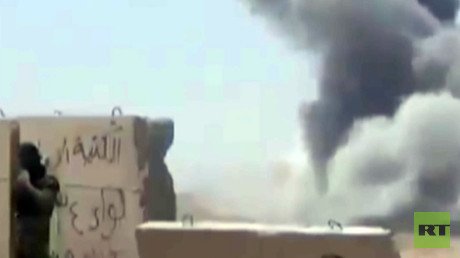New evidence emerges of US airstrike killing 2 Serbs in Libya, Pentagon sticks to denial – report

A growing body of evidence and accounts suggests that bad American intelligence led to the airstrike in Libya in February, which killed two Serbian embassy officials being held by terrorists. The Pentagon continues to deny any wrongdoing.
The two embassy personnel – communications chief Sladjana Stankovic and her driver Jovica Stepic - were being held at a suspected Islamic State (IS, formerly ISIS/ISIL) training camp in Sabratha, according to the latest accounts collected by the Intercept. The US bombed the camp just as ransom negotiations were beginning. Pentagon intelligence suggested there were no civilians at the site.
After a month of back-and-forth between the Serbian and US governments, the latter not only denies that Stankovic and Stepic were in the compound, but that any civilians at all were harmed in the airstrike.
“Immediately after the attack, in the first exchange of information with American military and security officials, we asked them if they knew that civilians were among the terrorists. We still haven’t received a definitive answer on that, and that’s what we’ll insist on. We expect a full report from the US and then we can comment on it,” the secretary-general of the Foreign Affairs Ministry, Veljko Odalovic, told the Intercept.
The two staffers were kidnapped in November, while traveling in a convoy near the area situated 50 miles west of the capital Tripoli. Also in the convoy was the ambassador to Libya, Oliver Potezica, with his wife and two sons. They managed to escape unharmed.
The day after the February 19 announcement of the attack by the US, the Serbian side claimed two of its embassy staffers had been killed. The Pentagon, which saw the attack as “very successful,” moved to deny any wrongdoing. In a statement it said: “Forces watched this training camp for weeks leading up to the operation, and at the time of the strike, there were no indications of any civilians present.”
Even autopsy results, consistent with the theory that the Serbs were killed in the airstrike, could not persuade the US to admit to bad intel analysis.
“When there are 12 wounds on a body sustained simultaneously, unequivocally from an explosion, then [the Pentagon] must show us any kind of evidence that would drag us into any other kind of story,” Serbian Prime Minister Aleksandar Vucic said in a statement. “It would have been nicer if they said, ‘We’re sorry, to the Serbs and Stepic and Stankovic’s families.’”
New accounts are coming to light, which appear to back up the view that the Pentagon could have done its job better.
An official with the Serbian Security Information Agency (BIA) spoke anonymously to the Intercept, revealing that there was intelligence-sharing on a large scale going on between the US, Serbia, France, Italy and Spain. This included information on the hostages’ conditions. There was consensus that they were being held in one of four sites within a six-mile radius of each other.
The trustworthiest report indicated the two staffers were being held at a compound about five miles from where US jets and drones struck, according to the Serbian intelligence officer.
What struck Serbian analysts as strange was that the house that was bombed wasn’t on the suspected site list. Its location 700 or 800 meters from the site of the November abduction seemed to indicate they were kept there for the duration of their captivity. The official speculates that the abductees weren’t allowed outside, which might have led to the view that there were no civilians at the compound.
The Intercept also talked to the mayor of Sabratha, Hussein Dwadi, who confirmed that “the house was completely destroyed, there were bodies everywhere.” He visited the hospital to view casualties in the aftermath, and said he clearly saw two foreign-looking victims among the dead.
“The claim that the Serbians died anywhere other than in the airstrike is highly unlikely,” he said.
Someone had photographed the bodies when they lay in the airport morgue, then publishing the pictures on social media. After seeing them, Foreign Affairs Minister Ivica Dacic told reporters in Serbia they “indicate clearly” the circumstances surrounding Stankovic and Stepic’s deaths.
What was so disconcerting to the Serbs was the fact that a rescue operation was all but underway at the time. “We had strong assurances that the hostage situation would be over very soon, especially in the days immediately before the bombing,” secretary-general Odalovic, told the Intercept.
Apparently, intermediaries had been in contact with the kidnappers up to the time of the bombing. “We had indisputable evidence that they were alive,” Odalovic added.
This made the US backpedal somewhat: ambassador to Serbia, Kyle Scott, quickly moved to say that the Pentagon’s denial isn’t the official position of the US government. However, this did not stop American military intelligence from continuing to deny not just the fact of Stankovic and Stepic’s killing, but that any civilians at all were killed in their strike.
“We continue to assess the situation, but we have no indications that any civilians were killed during this strike," Pentagon spokesperson Lt. Col. Michelle Baldanza wrote to the Intercept on March 1.
Two days later, US Deputy Assistant Secretary of Defense Michael Carpenter held a meeting with Vucic in Belgrade. Both agreed the two countries will seek the “full truth about this case to be determined through investigation and information exchange,” an official release reads.
The mystery deepens further, as the Americans also say the strike was carried out with the knowledge of Libyan authorities. That is difficult to ascertain, since internal conflict-ridden Libya’s government, bureaucracy and overall security are in chaos.
As the probe continues, the United Nations refuses to admit there were any Serbian casualties. They weren’t included in the latest death toll report from Libya. A UN public information officer in Libya said: “There is still uncertainty as to how these deaths occurred and investigations are still ongoing.”
The climate of bad Pentagon intelligence leading to civilian deaths continues to persist. The Libyan compound fiasco comes after the January Afghanistan deaths of an Italian and American aid workers in a similar strike. Last year, a CIA drone strike in Pakistan killed two kidnapped foreign aid workers. All three incidents involve some form of intelligence misinterpretation by the US.














